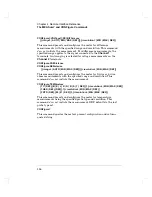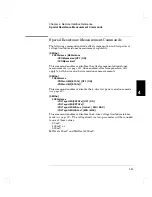
Using the INITiate and FETCh? Commands
The
INITiate
and
FETCh?
commands provide the lowest level of control
(with the most flexibility) of measurement triggering and reading
retrieval. Use the INITiate command after you have configured the meter
for the measurement. This changes the state of the triggering system
from the “idle” state to the “wait-for-trigger” state. Measurements will
begin when the specified trigger conditions are satisfied after the
INITiate
command is received. The readings
are
placed in the meter’s
internal memory (up to 1024 readings can be stored). Readings
are stored
in memory until you are able to retrieve them.
Use the
FETCh?
command to transfer the readings from the meter’s internal
memory to the meter’s output buffer where you can read them into your bus
controller.
Configure the meter using the SENSe commands. For voltage
measurements on two channels, you can configure each channel
independently by specifying either SENSe1 or SENSe2. Once configured,
use the ROUTe:TERM command to switch between the input channels.
The INIT and FETCh? commands use the meter’s memory. You can
defeat the storing of readings, and still obtain the statistics on the
readings using the DATA:FEED command. See page 150.
4
Chapter 4 Remote Interface Reference
Simplified Programming Sequence
131
Summary of Contents for 34420A
Page 1: ......
Page 2: ......
Page 13: ...1 Quick Start ...
Page 31: ...2 Front Panel Operation ...
Page 55: ...3 Features and Functions ...
Page 117: ...4 Remote Interface Reference ...
Page 200: ...5 Error Messages ...
Page 213: ...6 Application Programs ...
Page 245: ...6 Chapter 6 Application Programs Microsoft Excel Macro Example 245 ...
Page 246: ...Chapter 6 Application Programs Microsoft Excel Macro Example 246 ...
Page 247: ...7 Measurement Tutorial ...
Page 274: ...8 Specifications ...
Page 279: ...Dimensions Chapter 8 Specifications 34420A Nano Volt Micro Ohm Meter 280 ...
Page 294: ......
















































